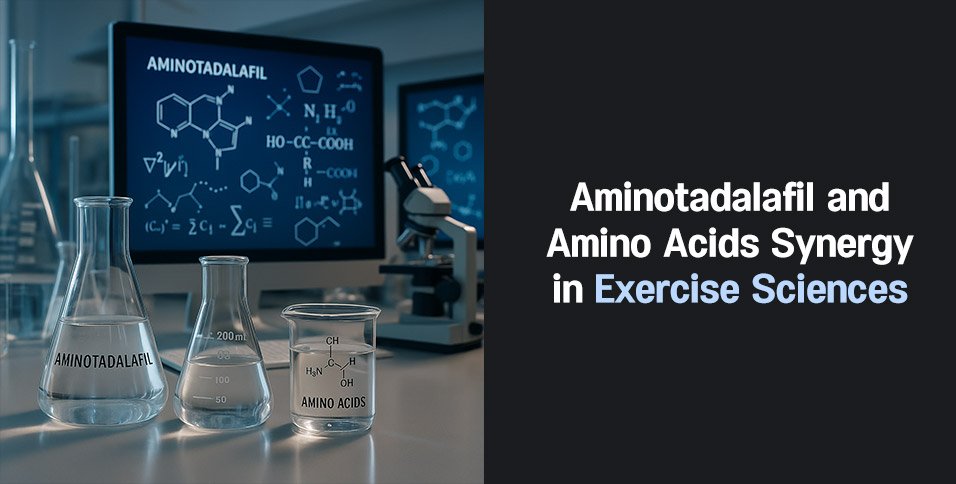Aminotadalafil is gaining attention as an advanced investigational compound in biochemical and exercise science laboratories. Closely related to tadalafil, this molecule represents a new generation of PDE5 inhibitor analogs under study for their potential to modulate muscle function, vascular response, and nutrient delivery in controlled research environments.
In parallel, amino acids—essential for protein synthesis and a cornerstone of metabolic studies—remain a primary subject in research focused on muscle performance, recovery, and cellular energetics.
Aminotadalafil: Mechanistic Insights and Laboratory Applications
Aminotadalafil is designed to inhibit the enzyme phosphodiesterase type 5 (PDE5), a regulator of cyclic guanosine monophosphate (cGMP) metabolism within vascular smooth muscle cells. By preserving cGMP levels, aminotadalafil supports sustained vasodilation—a process fundamental to optimizing nutrient and oxygen flow to active tissues in exercise-related experiments.
Mechanistic Advantages
- Extended Vasodilatory Effects: The molecular modifications in aminotadalafil are engineered to potentially prolong the half-life of cGMP, providing more sustained vascular relaxation in isolated tissue studies.
- Enhanced Bioavailability in Research Media: Early investigations suggest aminotadalafil structure may improve solubility in various experimental buffers compared to first-generation analogs.
- Potential for Targeted Studies: Research settings can leverage aminotadalafil’s selectivity for PDE5 to precisely measure downstream biochemical events, such as nitric oxide signaling and endothelial cell response.
Laboratory Use Scenarios
Aminotadalafil is utilized in a variety of in vitro models to study vascular responsiveness, the impact of cGMP modulation on cellular energetics, and the kinetics of muscle fiber contraction and relaxation under simulated exercise conditions. These research pathways support broader investigations into muscle fatigue, metabolic adaptation, and nutrient partitioning, while ensuring all activity remains within tightly regulated laboratory environments.
Amino Acids: The Building Blocks of Fitness Science Research
Amino acids form the molecular foundation for all protein synthesis and are fundamental to research on muscle hypertrophy, repair, and metabolic adaptation.
Core Functions in Experimental Design
- Protein Synthesis Pathways: Essential amino acids (EAAs) and branched-chain amino acids (BCAAs) activate critical cellular pathways, such as mTOR, which are frequently monitored in muscle cell cultures.
- Metabolic Flexibility: Certain amino acids serve as direct fuel sources in experimental endurance models, being metabolized through pathways such as gluconeogenesis and the Krebs cycle.
- Redox Balance and Recovery: Glutamine, glycine, and other amino acids are studied for their role in maintaining redox homeostasis and supporting post-exercise cellular repair in tissue and cell-line experiments.
Research Protocol Integration
Research-grade amino acids are prepared in precisely measured concentrations and are often delivered in custom combinations tailored to the experimental objectives—whether testing for protein synthesis, fatigue markers, or recovery rates in cell and tissue samples. A broad selection of research-grade Amino Acids for sale is available to laboratories aiming to investigate the next frontiers of performance science.
Synergistic Research: Aminotadalafil with Amino Acids
A rapidly growing area in exercise science is the investigation of how vasodilatory agents like aminotadalafil may interact with amino acid supplementation in research models.
Theoretical Synergy
- Augmented Nutrient Delivery: By promoting vasodilation, aminotadalafil may facilitate greater movement of amino acids into experimental muscle tissue, supporting more efficient protein synthesis and cellular repair processes in a controlled setting.
- Improved Metabolic Waste Removal: Increased circulation in perfused muscle or vascular models could enhance the clearance of metabolic byproducts, allowing amino acid-driven recovery mechanisms to function optimally.
- Optimized Study Protocols: Combining these compounds allows researchers to measure the interplay between vascular modulation and nutrient signaling, gaining deeper insight into the molecular choreography of exercise and adaptation.
Experimental Approaches
Laboratories may design sequential or combined compound administration protocols, using advanced tissue engineering, cell co-culture, or perfusion bioreactor models. Outcomes typically include quantifying cGMP, amino acid uptake, protein turnover, and contractility indices.
Analytical Methods and Best Practices
High-fidelity data is essential in scientific inquiry. Modern laboratories employ multiple analytical tools to ensure experimental integrity and data reproducibility.
Analytical Techniques
- High-Performance Liquid Chromatography (HPLC): Used for precise quantification of both aminotadalafil and individual amino acids in complex mixtures.
- Mass Spectrometry (MS): Confirms compound identity, assesses purity, and monitors metabolic transformations in research samples.
- Spectrophotometric Assays: Quantify signaling molecules such as cGMP or ATP in cell extracts.
- Enzyme-Linked Immunosorbent Assays (ELISA): For sensitive detection of protein and peptide markers related to muscle function.
Research Documentation
Detailed logbooks, batch records, and digital tracking ensure all experimental variables—including compound origin, preparation dates, and experimental conditions—are recorded for reproducibility and compliance.
Formulation, Stability, and Storage for Research Compounds
The quality and consistency of results depend on careful preparation and storage:
- Solubility Testing: Ensures compatibility with various buffer systems used in in vitro and ex vivo models.
- Stability Assessments: Periodic analysis (e.g., by HPLC) verifies that aminotadalafil and amino acid solutions remain active and uncontaminated throughout the duration of experiments.
- Storage Protocols: Compounds are stored at controlled temperatures and protected from light and moisture to preserve activity.
Laboratory Safety, Compliance, and Regulatory Context
Research with aminotadalafil and amino acids is governed by strict safety protocols. All preparations and experiments are conducted in accordance with laboratory chemical safety regulations. Personnel use appropriate PPE and dispose of all materials following hazardous waste guidelines. No study protocols or product materials are approved for clinical or dietary use, and all experimentation is confined to laboratory settings for scientific purposes only.
Future Directions in Fitness Science Research
The future of exercise biochemistry is moving toward integrated, multi-compound experimental systems:
- Targeted Nanoformulations: Exploring novel delivery systems for more precise application in laboratory models.
- Systems Biology Approaches: Leveraging omics technologies (proteomics, metabolomics, transcriptomics) to map the full spectrum of cellular responses to combined interventions.
- High-Throughput Automation: Adoption of robotics and AI for rapid screening of compound combinations, generating larger and more diverse data sets.
Ongoing updates and research trends are covered in dedicated industry resources, such as Global Healthcare Magazine.
Conclusion
Aminotadalafil and amino acids represent key pillars of current exercise science research, with applications ranging from vascular modulation to nutrient-driven muscle protein synthesis. Their study is driving forward new insights into muscle adaptation, fatigue management, and metabolic optimization—all within rigorously maintained laboratory environments and strictly for research use. The synergy between advanced vasodilatory compounds and foundational nutrients offers a dynamic research landscape with broad potential for scientific advancement.



















